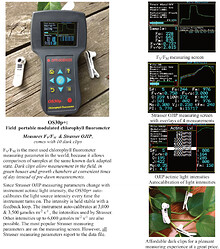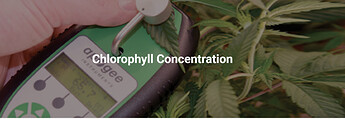These links and the guide by Opit-Sciences are a great primer. They will get anyone up to speed on using chlorophyll fluorometers as a plant health and stress diagnostic tool.
Chlorophyll fluorometry offers a wide array of applications for plant cultivation. Especially when paired with stomatal conductance measurements using porometry (cheaper) or gas (expensive) analysis and chlorophyll concentration.
Topic overviews:
- Chlorophyll fluorescence (Wikipedia): Measuring stress and stress tolerance
- Chlorophyll fluorescence - a practical guide (Journal of Experimental Botany)
Opti-Sciences (“The Standard in Plant Stress Measurement Systems”):
- Desktop Plant Stress Guide v6.2 (attached as a PFD)
- Desk Top Plant Stress Guide Reference List v6.2 (attached as a PFD)
High-end chloropyll flurometers, like the Walz PAM-2500 or LI-COR LI-600 (porometer + chlorophyll fluorometer) get quite expensive. But we don’t have to sacrafice quaility for cost using the Opti-Sciences OS30p+ (dark adaptation measurement) at $2,650.
For indoor cannabis, we only need a dark adaptation chlorophyll fluorometer unless grow room temp exceeds 30’C (86’F) - the point at which plant heat stress occurs (impaired Rubisco activation state). For overly warm indoor (>84’F), outdoor, and greenhouse growers, you’ll want a Chl fluorometer that provides light-adapted measurements as well; for example, the OS1p ($7,250 or $8,950 w/PAR clip) from Opti-Sciences.
Chlorophyll concentration is used for nutrient stress analysis (N and S) and other plant health and stress indices. For Chl concentration measurements, look no further than the Apogee Chlorphyl concentration meter ($1,595), which Opti-Sciences produces for Apogee. You’ll want to buy the Apogee branded version because they included a cannabis leaf calibration factor, while Opti-Sciences does not. Apogee did the work to create the calibration factors for 36 different plant and tree species and a general setting for all other species.
Lower cost porometers are available from Meter Group (SC-1) and Delta-T (AP4). I’m collecting quotes from them tomorrow.
The instruments mentioned above (chlorophyll fluorometer, porometer, and chlorophyll concentration meter) will provide an outstanding array of plant health and stress analyses for growers seeking to perfect their craft. The next level would be a portable photosynthesis meter, like the LI-COR LI-6800 I linked above (under stomatal conductance measurements using gas analysis).
I plan to purchase a wide array of research-grade instruments for field analysis of cannabis plant health and stress, including but not limited to the tools I described above. For example, I’m integrating Apogee’s research grade horizontal infrared ratiometers for leaf surface temperature (LST) measurements with GrowLink for the correct calculation of VPD. Which I’m using to control fogging/dehumidification based on my leaf VPD setpoints. Once I have these tools, I’ll write a few threads on their application for cannabis, including actual measurements and results of their use in our grow.
I’m really excited for phase two when I’ll have a custom-built R&D room I design. And a couple of R&D plant growth chambers from Conviron (the same company Dr. Bugbee uses at Utah State). Plus, my cannabis cultivation research capstone: whole plant gas exchange chamber for photosynthesis and growth studies (effects of light spectra, PPFD, nutrients, CO2, VPD, hydroponic and root media, and so on). At which point I plan to write a number of open source white papers on my findings.
Desk Top Plant Stress Guide Reference List 6.2.pdf (196.6 KB)
Desktop Plant Stress Guide 6.2.pdf (384.1 KB)

